Animation &Independent Animation 21 Jun 2011 07:04 am
Kathy Rose – Filmmaker/Performance Artist
- Kathy Rose has had a long and esteemed career doing personal animation. She made her name, at first, with the animation style she began at CalArts and continued on into the 70′s with her gem of a film, PENCIL BOOKLINGS. She took a 90° turn combining her animation with her dance and performance art via her 1983 piece, PRIMITIVE MOVERS. Since then she has developed this very personal and individual art form with many more theatrical pieces and video pieces.
I had a close eye on Kathy’s original animated films, but have lost track of the performance works. It was with some excitement and interest that I contacted her to ask several questions about her more current work and have been pleased for the chance to catch up – a little bit.
Q. To begin with, can you tell us about your beginnings; why you gravitated toward animation in the first place, and what steps you took?
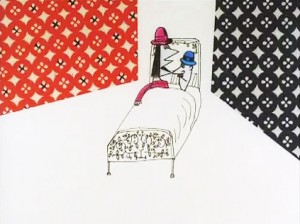 I was a film major at the Philadelphia College of Art, and while there, I saw the animation of Yoji Kuri, specifically – his film Ai (pictured right). I was totally enchanted with his work. That and an interest in photography and collage led me to animation. My thesis project was a live action film, called Portraits, but included pixilation and some cut out animation which I projected onto a live face in the film. The project was a series of portraits of friends, the
I was a film major at the Philadelphia College of Art, and while there, I saw the animation of Yoji Kuri, specifically – his film Ai (pictured right). I was totally enchanted with his work. That and an interest in photography and collage led me to animation. My thesis project was a live action film, called Portraits, but included pixilation and some cut out animation which I projected onto a live face in the film. The project was a series of portraits of friends, the
last – a self portrait – included excerpts of the other pieces, and finally this projection, all signifying our projection of others into our self image.
I also was training in dance and performing with a multi-media group in Philadelphia called Group Motion, started by former students of the great German expressionist dancer Mary Wigman. This experience would have an enormous impact on me in the coming years.”
When I left PCA, in 1971 I started to teach myself animation. My father – who was a photographer – gave me $1000 as a graduation gift to make an animated film. I did several explorations, using drawing pads to create the animation. Movers (on my site) was the last piece I made in that series before going to Cal Arts.
Q. You graduated from CalArts in 1974 with a class that produced a number of important non-linear filmmakers, such as Adam Beckett, Dennis Pies, Joyce Borenstein and yourself, who turned Independent animation on its ear. Can you tell us a bit about those years; was there a particular influence on you all?
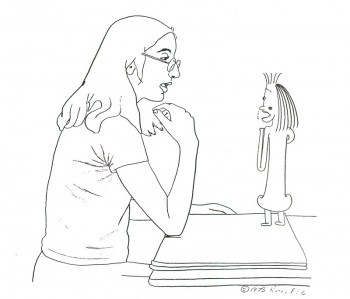 My time at Cal Arts was absolutely magical. Especially because prior to going I had been sequestered, working in an office in N.Y. while I taught myself animation. I saw that Cal Arts had a graduate program in animation, and thought that would be a great way to follow this star. The whole atmosphere at Cal Arts was very exciting – I think it probably still is. Jules Engel was an amazing teacher. He said very little, but when he did, it turned your life around – I am still inspired by his zen style of teaching. The department was small – only around 8 people at the most worked in the animation room, and some worked at home. Adam Beckett worked during the night – at home or in the optical printer room. He and I were in a relationship from 1972-74, and shared a lot about the animation we were working on. Dennis Pies (now Sky David) also worked in his dorm, as did Joyce. But we were all drawn together not just in our department, but with the rest of the Cal Arts community. For awhile I took some dance at the school along with another animator Lisa Rose. (no relation). An animator who was very influential on our group of artists was Jim Gore, who was not a student at Cal Arts. Adam had connected with him and his films. Dream of the Sphinx, and The Letter had a powerful effect on us. It was Jim’s very free, metamorphisizing style – which at the time was a revelation and led to a new way.
My time at Cal Arts was absolutely magical. Especially because prior to going I had been sequestered, working in an office in N.Y. while I taught myself animation. I saw that Cal Arts had a graduate program in animation, and thought that would be a great way to follow this star. The whole atmosphere at Cal Arts was very exciting – I think it probably still is. Jules Engel was an amazing teacher. He said very little, but when he did, it turned your life around – I am still inspired by his zen style of teaching. The department was small – only around 8 people at the most worked in the animation room, and some worked at home. Adam Beckett worked during the night – at home or in the optical printer room. He and I were in a relationship from 1972-74, and shared a lot about the animation we were working on. Dennis Pies (now Sky David) also worked in his dorm, as did Joyce. But we were all drawn together not just in our department, but with the rest of the Cal Arts community. For awhile I took some dance at the school along with another animator Lisa Rose. (no relation). An animator who was very influential on our group of artists was Jim Gore, who was not a student at Cal Arts. Adam had connected with him and his films. Dream of the Sphinx, and The Letter had a powerful effect on us. It was Jim’s very free, metamorphisizing style – which at the time was a revelation and led to a new way.
Q. We came to know you through your early animation work which was all very non-linear. filmically but linear graphically. MIRROR PEOPLE, MOVERS, THE DOODLERS and particularly PENCIL BOOKLINGS all had a large impact on the Independent movement of the late 70s early 80s. Can you speak a bit of this period in your work?
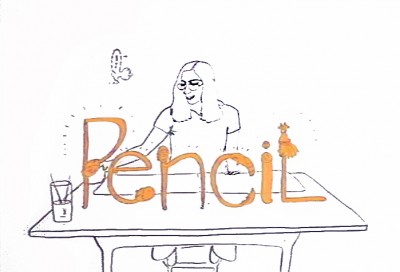 The wonderful input of Jules led me to MIRROR PEOPLE, THE MYSTERIANS, THE ARTS CIRCUS, THE MOON SHOW. I had graduated and was working at Cal Arts while I made The Doodlers, where I used the Cal Arts facilities. PENCIL BOOKLIGS was made in N.Y. with an AFI grant. All these films were the result of my exposure to the fertile atmosphere at Cal Arts, and also my fascination with Yoji Kuri, While I was at Cal Arts, I had started to correspond with Mr. Kuri, and he visited with my family in N.Y. at Thanksgiving. He then came to Cal Arts, and I finally met him. (I even saw him later in 1994 when I was a judge at the Hiroshima Animation Festival, and visited his studio, was taken to dinner (with a translator – Yoji spoke no English).
The wonderful input of Jules led me to MIRROR PEOPLE, THE MYSTERIANS, THE ARTS CIRCUS, THE MOON SHOW. I had graduated and was working at Cal Arts while I made The Doodlers, where I used the Cal Arts facilities. PENCIL BOOKLIGS was made in N.Y. with an AFI grant. All these films were the result of my exposure to the fertile atmosphere at Cal Arts, and also my fascination with Yoji Kuri, While I was at Cal Arts, I had started to correspond with Mr. Kuri, and he visited with my family in N.Y. at Thanksgiving. He then came to Cal Arts, and I finally met him. (I even saw him later in 1994 when I was a judge at the Hiroshima Animation Festival, and visited his studio, was taken to dinner (with a translator – Yoji spoke no English).
Initially, when I first entered Cal Arts, I was sure I did not want to work with narrative, and I said so to Jules, who was very amenable. I also missed the experience of dancing, and the music associated with it, especially rhythms. (I am currently studying Japanese Taiko drumming).
I think both the dance and rhythmical influences are strongly apparent in these Cal Arts pieces.
With PENCIL BOOKLINGS, I was moving in the circle of New York animators and I think although the storyboard was designed pretty early on, I was influenced somewhat by these associations, especially George Griffin‘s TRICKFILM.
Q. PENCIL BOOKLINGS was voted one of the 10 Best Films in the world by the Hiroshima Intl Animation Festival in 1976. You seemed to have reached the top with this animated form and you moved on to the dance/movement videos. Your 1983 film, PRIMITIVE MOVERS, included your dancing with a group of animated dancers, very much in your linear style. Can you speak about what caused your big change – incorporating yourself into the videos.
PENCIL BOOKLINGS was definitely an apex for me, and also left me at a decisive point. After I completed it, my father had passed away, and I had taught as a Visiting Lecturer at Harvard for a year, and I was working for R.O. Blechman on his Soldier’s Tale. I knew only that I didn’t want to return to what I had done, and I was feeling a strong pull to be performing again. But I had never performed solo, and was somewhat lost at what direction to take.
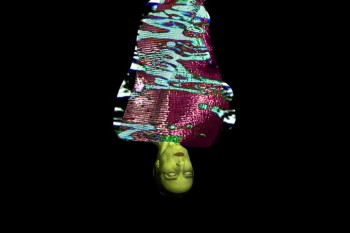 At that point, two things happened. I was living in Tribeca, and one weekend I decided I would just wander in Soho and see where it led me. I ended up at the Bleecker St. Cinema where there was a Marilyn Monroe double bill. This told me I wanted to perform again. (Ironically the first film I remember being taken to as a child was â€Some Like it Hotâ€)
At that point, two things happened. I was living in Tribeca, and one weekend I decided I would just wander in Soho and see where it led me. I ended up at the Bleecker St. Cinema where there was a Marilyn Monroe double bill. This told me I wanted to perform again. (Ironically the first film I remember being taken to as a child was â€Some Like it Hotâ€)
At the same time I received an NEA grant to make an animated film. I decided to mix the two, make an animated film I would dance with. Jules had actually told me almost 10 years before that he could see me dancing with my films. At the time I thought he was crazy, but it demonstrates his intuition. R.O. Blechman also was very encouraging about the idea of combining these. I began taking dance classes again, and ended up studying African dance (for 5 years actually). I was very interested in the Diaghilev productions and his work with set designers for ballet, and in particular the costume designs of Sonia Delauney. In addition, Bob Blechman took the whole studio to see Abel Gance’s Napolean, which was being shown at Radio City Music Hall with a live orchestra – the score by Carmine Coppola. This production was absolutely amazing to me, the effect of the live music on the film made it a dimensional experience, and this was a pivotal moment for me.
I also found seeing Barbara Morgan’s photos of Martha Graham’s PRIMITIVE MYSTERIES clicked for me. Until then I hadn’t really connected with what choreography meant to me. But seeing the stunning, visual, and symbolic group formations in this piece, showed me that dance could be graphic, and this was something I could connect with.
I took a year to produce the animation, and mapped out choregraphy as I drew. Originally I thought I was making a 10-15 minute piece, but it turned out to be 30 minutes. I had a wonderful animation student as an intern – Monica Kendall from Chicago – who worked with me every day. At this time I was also introduced to Mary Bright who I interviewed to design the costume. I knew as soon as I met her at the door, that she was the one. She wore a very big circle earring on only one ear, and that told me everything I needed to know about her dramatic graphic sensibility.
The first performance of PRIMITIVE MOVERS was for a private audience, and it was the most frightening thing I’d ever done. After many performances, I developed my self-confidence and it totally altered me over time.
Q. In PENCIL BOOKLINGS your interplay with your characters came by animating yourself as a character in the film. In PRIMITIVE MOVERS the animated characters and shapes move into your live performance with you as the prime character. Was this part of the goal of the change in direction, or was it part of the result of the change in direction?
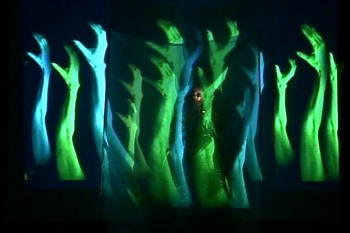 I think in both pieces I am the central character (if you don’t count the pencil). The big difference is that working with projection on something live forces you to work with a very different reality, where everything is not in your control. So many decisions and scenes are the result of the challenges that you meet in integrating the live with the two-dimensional. In PRIMITIVE MOVERS, I basically had to learn to take command, and be the leader, director in my performance itself – it is related to the central role I play in PENCIL BOOKLINGS, but has to be acted out in a much more dramatic way. I often had friends come to rehearsal, and also used a mirror. The input of certain people was key to my development of this genre.
I think in both pieces I am the central character (if you don’t count the pencil). The big difference is that working with projection on something live forces you to work with a very different reality, where everything is not in your control. So many decisions and scenes are the result of the challenges that you meet in integrating the live with the two-dimensional. In PRIMITIVE MOVERS, I basically had to learn to take command, and be the leader, director in my performance itself – it is related to the central role I play in PENCIL BOOKLINGS, but has to be acted out in a much more dramatic way. I often had friends come to rehearsal, and also used a mirror. The input of certain people was key to my development of this genre.
Q. You started projecting shapes onto yourself, essentially acting as the screen for the animation. You make it seem as though the garment, itself, is alive and animated. This with other animated incarnations of yourself moving floating about you.
Unfortunately, I haven’t seen any of your live performances but have watched every video clip I can find. I’m sure I’m missing a lot. I wonder if you can talk about the difference between the live and the video.
It has always been a tremendous challenge to communicate the live event through a basically documentative video. It has actually taken me years to come to terms with it. Some of my early best video recordings were done by Swiss television, of PRIMITIVE MOVERS, and SYNCOPATIONS. I also found when I worked on my 1999 live piece KLEOPAT’RA, I was creating scenes to be used as film clips to run during the performance while I was changing costume off-stage, or to emphasize a stage action, and it allowed me to refine my approach.
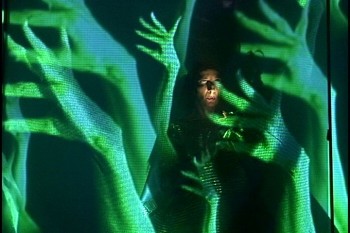 Basically, the live performance of any artist, has an entirely different sense of time from a film or video. In the live event, we are more prepared to wait for what happens because we are there, and there is a suspense, an excitement in the reality of the performer being there, live on the spot. And anything that happens integrating two-dimensional imagery seems impossible, hallucinogenic, and is therefore riveting. In my work it also becomes very sculptural. Often things I thought would be rather ordinary when I shot them as elements, like the floating hair for KLEOPAT’RA (and also QUEEN OF THE FLUIDS – which is a video re-working of the latter piece). When I projected this imagery onto a dancer, I was astounded at the architectural event that ensued. I definitely believe in being open, even waiting like a fisherman, for accidents.
Basically, the live performance of any artist, has an entirely different sense of time from a film or video. In the live event, we are more prepared to wait for what happens because we are there, and there is a suspense, an excitement in the reality of the performer being there, live on the spot. And anything that happens integrating two-dimensional imagery seems impossible, hallucinogenic, and is therefore riveting. In my work it also becomes very sculptural. Often things I thought would be rather ordinary when I shot them as elements, like the floating hair for KLEOPAT’RA (and also QUEEN OF THE FLUIDS – which is a video re-working of the latter piece). When I projected this imagery onto a dancer, I was astounded at the architectural event that ensued. I definitely believe in being open, even waiting like a fisherman, for accidents.
With a video documentation, we tend to assume, in almost a lazy way, that what we are watching is possible, because it is like any other film. But I have found that I can still communicate the design, the theatrical sense in a video document, and of course its wonderful to be able to put these things on the web.
Q. The music throughout your pieces is strong. Do you collaborate with your composers or is it found music (or both)?
I have collaborated with several musicians – C.P. Roth had created rhythms for a piece he was doing for another artist. I heard it when I lived in Tribeca – which was next door to the Franklin Furnace where thie music was playing. I approached him about using the rhythms for SYNCOPATIONS. He also composed wonderful music for my performance piece SHE, which I also used for the later video of the same name.
Walther Giger in Zurich composed some really great music for me – I used one piece for my performance KABUKIMENKO, and a scene from it for a later video of the same name. I was studying flamenco and he has worked with Spanish guitar so it was a great fit.
Toshi Makaihara created sound for KLEOPAT’RA, and I was permanently affected by that creative experience. It drew me into the idea of pure sound, and since then I have made most of my tracks using sound from objects, instruments I recorded myself.
Toshi has come to my classes at The University of the Arts, where I have taught a number of courses, most lengthily Image and Performance, an interdisciplinary workshop. He completed charmed the class by playing every object in the roon.
Q. The lively and strong video SYNCOPATIONS has you dancing about projected mirror images of yourself. All the while images are projected onto yourself. The costumes are so vivid that it leads one to believe that the video is making a statement about fashion. I watch the very dark shadow of the live you falling onto the screen images of yourself and noticing the strong blacks against the strong luminescent white of your live gown. It’s a stirring video. Any comments about this piece?
The integration of the costume with the film projections (it was film then) was very carefully planned. The use of white and black (which is even more important in earlier scenes of this 50 minute piece) were absolutely key to the designing.. I worked with several dancers, having them come to my loft every week, and prepared choreography for them based on a rough storyboard I had made. Sometimes I shot a film test of their movements. There were seven scenes of which only two are seen on line currently. When I felt the choreography for a section was working, I shot Polaroids (this was 1985-7) and created a storyboard from those, which I was able to use for the dancers, and cameraman at the final shoot. We had several shoots, over a year or two.
My assistant cameraman, Roger Grange was extremely helpful and competent and I worked with him in subsequent years, especially on KLEOPAT’RA.
When the film was completed of the dancers, I rehearsed, using a mirror, and choreographed my movements for the live on stage component. The piece was meant to convey the whole idea of syncopations, rhythms, both our generic idea of speed in rhythms, but also of the hidden and inner rhythmical universal pulse beyond the obvious. It was about visual rhythm in the form of patterns too, in addition to the aural interpretation.
I was very influenced by some early modern dance, espedially in Germany – a number of those dancers had used scarves for interpretative dancing.
The premiere was in Santa Fe, at the Contemporary Art Center. I traveled with a simple costume case into which all the costumes went, including the hoop. People were amazed after the shows when I would return this entire magical illusion into a simple 3’’x3’ case.
And I should also mention that all during the time I was doing these performances, from 1983, no-one had really seen anything like this before. Later, when I was teaching I discovered a wonderful piece by Robert Whitman called Prune Flat (1965), which was closest to what I had done.
But my use of animation, and then live action in this very precise way with the live performer, explored so thoroughly was a very exotic bird, and I had a lot of press with this work.
Q. In QUEEN OF THE FLUIDS it would seem that an Oriental goddess gives birth to liquid/smoky characters that float about you. At one point you make yourself the screen as black tears run down your face while liquid characters dance around your head. The imagery is beautiful and the non-linear story (though I’ve only seen the short excerpts on our site) is deep. Can you speak of this film and the impetus behind it.
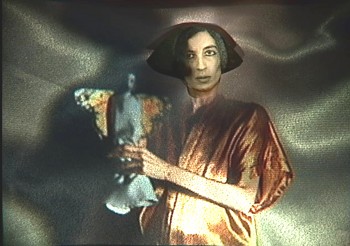 QUEEN OF THE FLUIDS (2003) , which was done with a Guggenheim Fellowship in Performance Art, was a chance to create a video using elements and scenes from my live performance – KLEOPAT’RA,(1999) which I had worked on for 5 years. The narrative differed. In KLEOPAT’RA, it opened with the formation of a statue In film clips (shown while I lay on the ground hidden in a gold pleated fabric), gold dripped into the body, the eyes dripped on, etc. Then a series of scenes followed with an imaginary landscape of the queen. I was integrating Egyptology and Japanese aesthetic.
QUEEN OF THE FLUIDS (2003) , which was done with a Guggenheim Fellowship in Performance Art, was a chance to create a video using elements and scenes from my live performance – KLEOPAT’RA,(1999) which I had worked on for 5 years. The narrative differed. In KLEOPAT’RA, it opened with the formation of a statue In film clips (shown while I lay on the ground hidden in a gold pleated fabric), gold dripped into the body, the eyes dripped on, etc. Then a series of scenes followed with an imaginary landscape of the queen. I was integrating Egyptology and Japanese aesthetic.
At the end, the gold dripped out, the eyes emptied, and the figure was left vacant, empty, ready for transport to the other side. There was then a large pyramid, projected onto a veil, into which she entered signifying her passage from the real world. This piece was generated by my witnessing at her bedside, of my mother’s passing. It was an experience that changed me forever, and which I can never forget. In fact the piece She (the original theatrical work) was also a result of this.
My description of QUEEN OF THE FLUIDS says:
“Through rain falling backwards a golden queenly being rises up. In a poetic introductory scene, the gold drips out of her body, and her eyes are shed. Entering through the eerily empty orbs into her brain, we discover a metaphysical kingdom – a world of liquidity, and are led through the mind into an “under-realityâ€,arriving in the pure abstraction of consciousness. Finally, in “The Recovery of the Bodyâ€, her physical self is re-constructed, leading to “The Other Side of The Tapestryâ€, in which we arrive at a kind of “uber-surrealist†view of the artist and the symbolic mirror of herself.â€
This video represents a culiminating point in my performance generated imagery, and my first single channel video.
This piece is also influenced by such sources as the Futurist painter Boccioni’s “states of mind†drawings, bunjin-ga – the symbolic landscapes of Japanese art, and a fascination with puppetry and dolls.
I should also mention re your observation about cgi, that there is something about the reality of the actual projection (it was film) on the face, with the dripping eye scenes that makes it more magical. We were not doing it digitally, but in reality – the body was collaborating with the projection, and this makes it more “unbelievableâ€. One shot actually took 2 years because everytime we tried it, the two would not work together.
Q. Once again, in THE CATHEDRAL OF EMPTINESS, you turn to the oriental art playing off Bunraku puppets with the hand itself acting as a host of puppets moving around the screen. You perform wearing the beautiful white mask. It’s a strong film that clearly shows your love of the medium. Could you give us a few details about the creation of this piece?
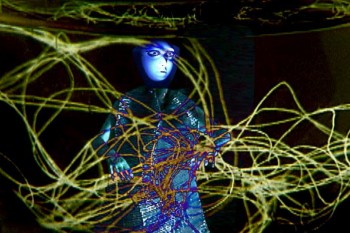 I do love this piece, and feel good performing it because it is really quite natural and organic in its structure. It does not require a lot of precise manipulation of props, costumes, etc. like the other performance works. The actual live performance uses the gold mask from QUEEN OF THE FLUIDS, because it turned out to be very easy to use, and is quite beautiful. I started out thinking I would
I do love this piece, and feel good performing it because it is really quite natural and organic in its structure. It does not require a lot of precise manipulation of props, costumes, etc. like the other performance works. The actual live performance uses the gold mask from QUEEN OF THE FLUIDS, because it turned out to be very easy to use, and is quite beautiful. I started out thinking I would
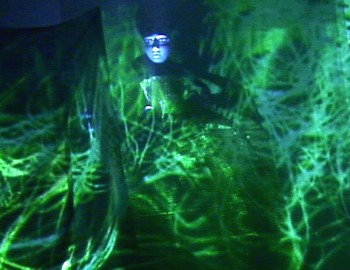 be making a performance version of my video THE INN OF FLOATING IMAGERY. This transformed a great deal, and I shot new scenes, including the trees (branches from our backyard), and the falling “petals†(paper strips that I cut in a form to extend their flight), etc.
be making a performance version of my video THE INN OF FLOATING IMAGERY. This transformed a great deal, and I shot new scenes, including the trees (branches from our backyard), and the falling “petals†(paper strips that I cut in a form to extend their flight), etc.
I also used a koto that my father had bought many years ago at Bloomingdales I think. The sound was constructed by me from this and other elements.
The title comes from an article I read in the NY Times by a reporter – who wrote that the bombing in Bosnia had left a church as an empty shell, like a “cathedral of emptinessâ€. I am very afraid of thunder, but enjoy having lightneing flashes and thunderous sounds in my work.
Q. You’ve obviously moved away from the characters in your films and have shifted to shapes, effects, textures and lighting. This is an interesting evolution and wonder if you’d care to comment?
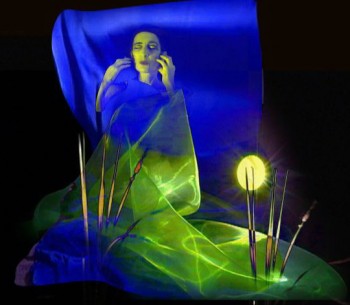 This is a very natural progression really. I feel that if you are not frightened occasionally by something you are making, then you are not advancing. I think there is definitely a big change from the early animation, to Pencil Booklings, Then in Primitive Movers I noticed the characters/figures seemed to become older, less childlike, which I took as a psychological and artistic advancement.
This is a very natural progression really. I feel that if you are not frightened occasionally by something you are making, then you are not advancing. I think there is definitely a big change from the early animation, to Pencil Booklings, Then in Primitive Movers I noticed the characters/figures seemed to become older, less childlike, which I took as a psychological and artistic advancement.
Each piece led me further and further along, and I find that abstraction I made in some of the performance pieces interests me by itself as well. More and more, I am influenced by the Japanese aesthetic, and my current project THE METAPHYSICAL PAINTINGS (a video) features mostly asian faces – quite often students of mine.
I also spent some time away from animation in the early 1990’s, working with only choregraphy and lighting design. The daunting precision of working with projections got to me and I needed a rest. I returned from this by doing Oriental Interplay.
Q. Where do you hope to go with future pieces?
I expect to continue to make videos, and performances. It is not really possible to predict what they will be, as the work changes by itself, and I follow it.
However I am also finding I am interested in creating projection design for other directors for theatrical, and dance productions, as well as for architect/designers.
I have also created some really beautiful installation pieces, and carrying out work like this, or projection design for architecture would make me very happy, because then I can see the work myself and enjoy the dimensionality.
Q. I know your website offers dates of your upcoming performances. Do you have any specific performances upcoming that you’d like to note? Do you find that booking performances is easier/harder/just different to navigate than the early days of sending out films to festivals?
Booking performances was always a lot of work – I had an agent in Europe for a while who got me a lot of work there, and I moved to Zurich for a while. I do find it is much more difficult now, largely because the economy is so bad. I performed for museums, film and dance festivals, universities, etc. (Performed for the Hiroshima Aniimation Festival, Cardiff Animation Festival, etc.)
I have kept up performances, and have exhibited my videos extensively in dance video festivals – which seem to be very open to a liberal interpretation of movement in media.
Of course the wonderful thing now is you can promote what you do easily. I used to cart around giant film cans for performances, and vhs tapes, even dvds would pile up as demo samples. Now we can send flyers in a paperless environment, and with one click, send people to websites with video clips.
Q. Do you have any thoughts about the current state of animation you’d like to share?
The web is really amazing because you can see all kinds of really unusual work. This is very good for animation, and really any kind of expressive video-making. I find when I teach, more and more, I show my classes things from the web, and they show me work also.
I think the whole thing has resulted in a very creative, positive exchange. It is probably very healthy and nourishing for artists of all genres. And probably there is less of a categorization – on sites like vimeo you can see any kind of really progressive interesting work, some animation, or film graphics, or installation related projection. It is a challenge to us all, but is a positive environment.
Early animation
“Syncopations” excerpt
Go here to see more samples of Kathy Rose‘s performance/animation samples.

on 21 Jun 2011 at 11:21 am 1.David Nethery said …
Wonderful interview. I’m glad to catch up on what Kathy Rose has been doing. I have never had an opportunity to see one of her live animation/dance performances , but the clips are fascinating. This is what keeps me coming back to your blog every day: one day we get screen shots and analysis of classic-era Disney studio Multiplane shots in Pinocchio , the next day an interview with independent animator/performance artist Kathy Rose. Variety the spice of life. (and inspiration for the artist).
on 12 Dec 2013 at 8:53 am 2.Rental Car Solo, sewa mobil murah, sewa mobil murah di solo, sewa mobil murah solo, sewa mobil solo murah, sewa mobil di solo murah, sewa mobil elf murah, rental mobil solo, rental mobil di solo, mobil murah solo, sewa mobil solo, mobil murah di solo, sew said …
Superb challenges completely, simply won a new viewer. Just what exactly can you highly recommend in terms of the put up that you just created some days before? Any convinced?
on 18 Dec 2013 at 12:32 am 3.sewa mobil solo, rental mobil solo said …
The things they say call at your competencies inside the pictures you’re. The earth wants much more ardent freelance writers as you that are not fearful to mention the direction they think. Constantly focus on a person’s center.
on 11 Feb 2014 at 9:50 pm 4.sewa mobil said …
Have you ever thought about writing an e-book or
guest authoring on other websites? I have a blog centered on the same information you
discuss and would love to have you share some stories/information.
I know my viewers would appreciate your work. If you are even remotely interested, feel free
to shoot me an e mail.
on 03 May 2014 at 7:01 am 5.katy perry dark horse lyrics on screen said …
Awesome post.
on 23 May 2014 at 8:02 am 6.stomach gas said …
I’m not sure where you’re getting your information, but great topic.
I needs to spend some time learning more or understanding more.
Thanks for fantastic info I was looking for this info for my mission.
on 05 Aug 2014 at 5:46 am 7.Rickie Litterer said …
Nice post, had a good read!